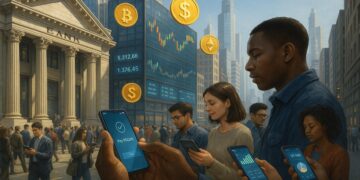The evolution of digital consumption and its impact on the American economy: trends and forecasts

The Shift in Digital Consumption: An Economic Perspective
The landscape of digital consumption has profoundly transformed over the last two decades. As technological advancements cascade through various sectors, Americans are increasingly engaging with digital platforms for consumption, leading to significant economic shifts. This phenomenon not only alters consumer behavior but also has far-reaching implications for the American economy.
Key trends that illustrate this evolution include:
- Rise of E-commerce: Online retail sales continue to surge, accounting for approximately 14% of total retail sales in the U.S. in 2022. The convenience of shopping from home combined with a wider array of products has fueled this rapid growth. Industry giants like Amazon have not only hacked traditional retail sales but also set a precedent for delivery speed and customer service, compelling other businesses to adapt swiftly to meet consumer expectations.
- Streaming Services Popularity: Services like Netflix and Spotify have displaced traditional media consumption, creating new revenue streams while disrupting established industries. For example, the U.S. music industry’s revenue from streaming reached $12.4 billion in 2021, showing a stark contrast to physical sales, which continue to decline. This transition impacts recording studios, concert venues, and even artist income models, as new revenue-sharing mechanisms develop based on streaming metrics.
- Mobile Usage Growth: With over 80% of internet users accessing the web via mobile devices, businesses are adapting to meet the needs of this on-the-go consumer base. Fast-food chains, retail brands, and service industries are now emphasizing mobile-friendly websites and applications, recognizing that a significant portion of e-commerce transactions occur via smartphones. For instance, in 2022, it was reported that mobile commerce accounted for nearly 23% of total e-commerce sales in the U.S.
This shift fosters not just new business models but also dictates economic policies and regulations. For example, state governments are grappling with sales tax regulations for online sales, while federal discussions around data privacy practices continue to evolve. These evolving frameworks can greatly impact both small entrepreneurs and large corporations in their digital strategy and operational compliance.
Moreover, as digital consumption continues to rise, it is crucial to discern the major impacts on GDP, employment, and industry structures. The expansion of the e-commerce sector has spurred job creation in logistics, technology, and customer service fields. However, traditional retail jobs are also at risk, highlighting the need for workforce retraining programs to assist those displaced by digital transitions.
Understanding these trends allows us to make informed forecasts about the future landscape of the American economy. By analyzing data from reputable sources, such as the U.S. Census Bureau and industry reports, we can anticipate how these digital changes will shape consumer habits and economic resilience moving forward. This growing emphasis on digital consumption not only highlights a shift in consumer preference but also underscores the importance of innovation in economic sustainability.
Transformative Impacts on the American Economy
The evolution of digital consumption extends beyond mere consumer habits; it catalyzes significant economic changes, reshaping GDP contributions, job markets, and industry landscapes. To fully appreciate these shifts, it is essential to delve into measurable economic outcomes and projections that highlight the profound implications of this digital transformation.
One of the most notable aspects of this evolution is the quantifiable impact on the Gross Domestic Product (GDP). According to the Bureau of Economic Analysis, e-commerce has contributed approximately $874 billion to the U.S. economy in recent years. This figure represents about 4.3% of the total GDP, a statistic that underscores the importance of online commerce in the broader economic framework. Projected growth suggests that by 2025, e-commerce could account for as much as 15% of total retail sales, signaling a continued paradigm shift from traditional marketplaces to digital platforms.
Furthermore, the employment landscape is being reshaped as digital consumption patterns engrain themselves across various sectors. Research from the U.S. Bureau of Labor Statistics indicates a potential increase of over 1.2 million jobs in e-commerce-related positions by 2030, driven primarily by logistics, technology, and customer support. However, this growth in digital roles raises concerns for traditional retail employees, as projections show a potential decline in brick-and-mortar retail jobs by approximately 300,000 within the same period. This juxtaposition emphasizes the compounding need for effective workforce retraining initiatives to facilitate transitions into the digital economy.
An important facet of this transformation is the shift in consumer spending behavior. As digital platforms proliferate, consumers are now more inclined to shop online, prioritizing convenience and personalized experiences. A survey from Statista reveals that over 50% of American adults prefer online shopping due to its efficiency. Consequently, brands are adapting their marketing strategies to resonate with this trend, leveraging digital advertising, social media, and influencer partnerships to drive online sales.
Moreover, the proliferation of mobile commerce is revolutionizing purchasing behavior. As indicated by the National Retail Federation, mobile shopping accounts for über 40% of total e-commerce sales, reflecting consumers’ preferences for seamless experiences on smartphones and tablets. This trend necessitates that retailers enhance their mobile platforms and invest in sophisticated customer relationship management tools to capture this lucrative market segment effectively.
In summary, the impact of digital consumption on the American economy is multifaceted, influencing GDP, job creation, and consumer behavior. As we unravel the complexities of these trends, it becomes increasingly crucial for businesses and policymakers alike to recognize and respond to the shifting sands of consumer expectations and the evolving digital landscape. Preparing for the future will depend on innovative solutions and adaptive strategies that keep pace with the rapid evolution of digital consumption.
Consumer Trends Shaping the Future of Digital Ecosystems
As digital consumption continues to evolve, it is crucial to focus on the underlying consumer trends that are redefining economic landscapes across the United States. These trends not only influence market dynamics but also hold substantial implications for businesses and policymakers as they strive to adapt to an increasingly digital-centric economy.
One key trend is the accelerating growth of subscription-based services. In recent years, companies like Netflix, Amazon Prime, and Spotify have pioneered this model, drastically shifting consumer expectations regarding content delivery. According to a study by McKinsey, the number of U.S. households subscribed to at least one video streaming service surged to 80% in 2022, a significant rise from 50% only two years prior. This transition fosters a recurring revenue model that enhances predictability for businesses while promoting consumer loyalty. It is anticipated that subscription revenue in various verticals, including beauty and meal kits, will reach $478 billion by 2025, illustrating the profound economic impact of customer retention strategies.
Moreover, the demand for personalization is revolutionizing the way companies engage with consumers. Data from Salesforce indicates that an overwhelming 70% of consumers expect personalized experiences when interacting with brands. As a result, businesses are harnessing advanced analytics, artificial intelligence, and machine learning to gain insights into consumer preferences and habits. For instance, retailers increasingly implement AI-driven recommendation algorithms to curate product offerings tailored to individual tastes, thereby enhancing customer satisfaction and driving sales. Forecasts suggest that investments in personalized marketing technologies could reach upwards of $10 billion annually by 2024, highlighting the financial incentive for companies to adopt this approach.
The Rise of Social Commerce
Another prominent trend gaining traction within digital consumption is the emergence of social commerce. Leveraging platforms such as Instagram and TikTok, brands have started to harness social media as a sales channel, integrating commercial capabilities within traditional content platforms. According to eMarketer, social commerce sales in the U.S. are projected to exceed $56 billion by 2023, representing a considerable portion of the e-commerce market. This shift necessitates a reimagination of marketing strategies where storytelling and brand engagement take center stage, compelling businesses to innovate in how they connect with audiences while fostering authentic relationships.
Influence of Economic Factors on Digital Consumption
Digital consumption patterns are also tightly interwoven with broader economic trends such as inflation and shifts in disposable income. As inflationary pressures weigh on American households, the demand for discounted goods and affordability escalates. A recent report from the Consumer Price Index indicated that consumer spending on essential items has surged, while discretionary spending is witnessing a downturn. Companies that can pivot to address these changing priorities—whether through value-oriented offerings or bundled services—will likely capitalize on emerging market opportunities and reinforce consumer trust in their brands.
In addition, the influence of technological advancements cannot be understated. The accelerated deployment of 5G networks is anticipated to further enhance the digital shopping experience, enabling faster loading times and augmented reality features that enrich customer interactions. According to a report by the Federal Communications Commission (FCC), 5G technology could generate an economic impact of up to $500 billion by 2030 through enhanced connectivity and improved access to online services.
In summary, consumer trends such as subscription models, personalization efforts, the rise of social commerce, and the impact of economic variables are shaping the future of digital consumption in America. Recognizing these evolving dynamics is imperative for businesses looking to succeed in today’s fast-paced digital marketplace. The interplay of these trends will ultimately dictate the strategies adopted by companies while presenting opportunities for innovation and economic growth.
Conclusion
The evolution of digital consumption is reshaping the American economy in profound ways, driven by emerging consumer trends and technological advancements. The rise of subscription-based models has not only altered how consumers access products and services but has also created stable revenue streams for businesses. Companies that capitalize on these trends stand to benefit significantly; as projected revenues in subscription verticals could reach $478 billion by 2025.
Furthermore, the growing demand for personalization is transforming the consumer experience, with a notable 70% of consumers seeking tailored interactions. This trend necessitates that businesses invest in advanced analytics and AI technologies to meet expectations, reflecting a financial opportunity of potentially $10 billion annually in personalized marketing by 2024.
The emergence of social commerce highlights an essential shift in consumer purchasing behavior, where platforms such as Instagram have turned into vital sales channels, projected to exceed $56 billion in sales by 2023. These changes illustrate that marketing strategies must adapt to maintain audience engagement, blending entertainment with commercial transactions.
Finally, economic factors such as inflation and advancements in technology will continue to influence digital consumption patterns, requiring businesses to remain agile. Investing in tools that enhance customer engagement, like 5G connectivity, can significantly shape consumer habits, yielding an expected economic impact of up to $500 billion by 2030.
As these trends converge, companies must lean into innovation to navigate this intricate digital landscape successfully. In doing so, they will not only drive their growth but also contribute to a more dynamic and resilient American economy.

James Carter is a financial writer and consultant with expertise in economics, personal finance, and investment strategies. With years of experience helping individuals and businesses navigate complex financial decisions, James provides practical insights and analysis. His goal is to empower readers with the knowledge they need to achieve financial success.





